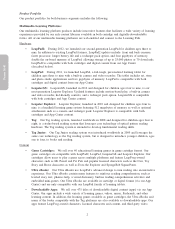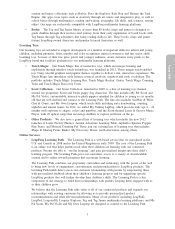LeapFrog 2012 Annual Report Download - page 20
Download and view the complete annual report
Please find page 20 of the 2012 LeapFrog annual report below. You can navigate through the pages in the report by either clicking on the pages listed below, or by using the keyword search tool below to find specific information within the annual report.
The success of our growing strategic focus on online products and services depends on consumer
acceptance of downloadable content and data collection, including our privacy practices.
Our multimedia platform products, such as the LeapPad2, the LeapsterGS, the Tag reading system, and some
of our learning toys, are designed to be connected to a computer that has Internet access in order to download
and access content and other features through our App Center and Learning Path. A growing percentage of our
sales comes from these multimedia learning platform products. As we focus on Internet-based products and
direct marketing to consumers through the Internet, any resistance by parents to buying children’s products
requiring a computer in order to download content, or errors related to the collection of data by us from
parents and children, could have a negative effect on our business and financial results. Further, concerns
about our practices with regard to the collection, use, disclosure, or security of personal information or other
privacy-related matters, even if unfounded, could damage our reputation and operating results. See also
‘‘System failures in our online services or web store could harm our business’’ below.
System failures in our online services or web store could harm our business.
The online aspects of our business have grown substantially in strategic importance to our overall business.
Any failure to provide a positive user experience in these services could have a negative impact on our
reputation, sales and consumer relationships. If consumer demand for accessing our App Center or our website
exceeds the capacity we have planned to handle during peak periods or if other technical issues arise, then we
could lose sales and customers could be inconvenienced or become dissatisfied with our products. Any
significant disruption to our App Center, website, internal computer systems, or those of our third-party
service providers, or malfunctions related to transaction processing on our online store or content management
systems, could result in a loss of potential or existing customers and sales.
Although our systems have been designed to reduce downtime in the event of outages or catastrophic
occurrences, they remain vulnerable to damage or interruption from earthquakes, floods, fires, power loss,
telecommunication failures, terrorist attacks, computer viruses, computer denial-of-service attacks, and similar
events. Some of our systems are not fully redundant, and our disaster recovery planning is not sufficient for
all eventualities. Our systems are also subject to break-ins, sabotage, and intentional acts of vandalism.
Despite any precautions we may take, the occurrence of a natural disaster or other unanticipated problems at
our hosting facilities could result in lengthy interruptions in our services. We do not carry business
interruption insurance sufficient to compensate us for losses that may result from interruptions in our service
as a result of system failures. Any unplanned disruption of our systems could result in adverse financial
impact to our operations.
Future operating results depend on the cost of our components and raw materials and our ability to
obtain these in sufficient quantities from our suppliers or alternative sources.
Because some of the components used to make our products currently come from a single or a limited number
of suppliers, we are subject to significant supply and pricing risks. Many components that are available from
multiple sources are at times subject to industry-wide shortages and significant commodity pricing
fluctuations. If our suppliers are unable to meet our demand for components or raw materials and we are
unable to obtain an alternative source or if the price available from our current suppliers or an alternative
source is prohibitive, our ability to maintain timely and cost-effective production of our products would be
seriously harmed and our operating results would suffer.
In addition, as we do not have long-term agreements with our major suppliers and cannot guarantee their
stability, they may stop manufacturing our components at any time with little or no notice. For example, in
2010, a sole-source supplier of an ASIC for one of our reading systems informed us that it was having
financial difficulties, which required us to negotiate the purchase of certain intangible assets from the supplier
in order to continue production of the ASIC. In addition, if we are required to use alternative sources, we may
be required to redesign some aspects of the affected products, which may involve delays and additional
expense. For example, the 2011 tsunami in Japan required us to replace a chip in the LeapPad. Although the
introduction of the new chip did not ultimately increase our cost for the product or materially affect its
performance, it introduced additional complexity into our supply chain and manufacturing processes, strained
our internal resources, and introduced risk to our launch date. If there are any significant interruptions in the
12
























